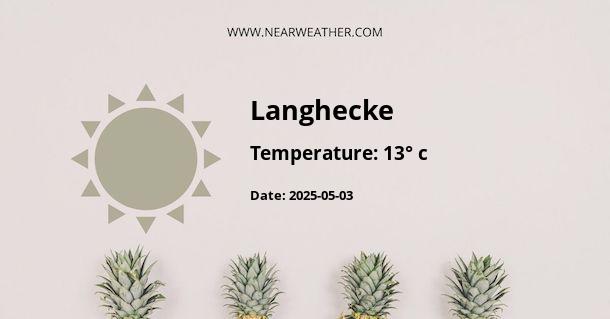Climate Overview of Langhecke, Germany
Langhecke, a small town in Germany, experiences a temperate oceanic climate with distinct seasons marked by relatively mild variations as compared to more continental regions. This detailed climate overview will delve into the weather patterns and phenomena typical to Langhecke, exploring averages in temperature, precipitation, and other meteorological factors throughout the year.
Seasonal Weather Patterns
Spring
Spring in Langhecke is characterized by gradually increasing temperatures and longer days. The season sees the end of the cold winter with the last frosts occurring typically in March. As the foliage starts to bloom, residents enjoy moderate weather conditions.
- Average Spring Temperatures: 4°C (39.2°F) to 15°C (59°F)
- Precipitation Range: 40 to 55 mm per month
Summer
Summers are generally mild to warm with occasional hot spells. Due to Langhecke's geographical location, it is not uncommon to experience rapid weather changes during this season, including thunderstorms brought by Atlantic low-pressure systems.
- Average Summer Temperatures: 14°C (57.2°F) to 24°C (75.2°F)
- Precipitation Range: 60 to 70 mm per month
Autumn
Autumn sees a decline in temperatures and daylight hours. The weather becomes more unpredictable, and first frosts usually appear by the end of November. This season is also known for its scenic beauty as the leaves change color.
- Average Autumn Temperatures: 6°C (42.8°F) to 14°C (57.2°F)
- Precipitation Range: 40 to 60 mm per month
Winter
The winters in Langhecke can be cold and damp, with temperatures often hovering around freezing. Snow cover is not consistent but can occur, particularly in January and February, the coldest months of the year.
- Average Winter Temperatures: -2°C (28.4°F) to 3°C (37.4°F)
- Precipitation Range: 45 to 70 mm per month
Monthly Temperature and Precipitation
The following tables provide a succinct representation of the monthly averages for temperature and precipitation in Langhecke, offering a closer look into the climate throughout the year.
| Month | Average Low (°C) | Average High (°C) |
|---|---|---|
| January | -2 | 3 |
| February | -1 | 5 |
| March | 1 | 9 |
| April | 4 | 15 |
| May | 8 | 19 |
| June | 11 | 22 |
| July | 13 | 24 |
| August | 13 | 24 |
| September | 10 | 19 |
| October | 6 | 14 |
| November | 2 | 7 |
| December | 0 | 4 |
| Month | Precipitation (mm) |
|---|---|
| January | 50 |
| February | 40 |
| March | 45 |
| April | 40 |
| May | 50 |
| June | 60 |
| July | 70 |
| August | 65 |
| September | 55 |
| October | 50 |
| November | 55 |
| December | 55 |
Extreme Weather Events and Climate Concerns
While extreme weather events are not a daily occurrence in Langhecke, the town is not immune to the wider impacts of climate change. Over recent years, episodes of extreme heat in summer and severe storms have increased in frequency, reflecting broader trends observed across Europe.
- Notable Climate Event: The summer of 2003 experienced a heatwave that affected much of Europe, including Langhecke, resulting in record-breaking temperatures.
- Climate Concern: Increased precipitation during winter months has led to concerns over flooding risks in the region.
Weather Advisories and Preparedness
Residents and visitors to Langhecke should be prepared for the potential of sudden weather shifts. Local authorities issue advisories related to heatwaves, storms, and frost, emphasizing the importance of staying informed through official channels such as the Deutscher Wetterdienst (German Weather Service).
- Weather Advisory Resources: Radio, television, and online platforms provide timely information.
- Preparedness Measures: Emergency kits, home weatherproofing, and community infrastructure against flooding are recommended.
Implications for Tourism and Agriculture
Langhecke's climate plays a critical role in shaping the local economy, especially in sectors such as tourism and agriculture. The pleasant summer months attract tourists for outdoor activities, while the fertile growing season supports a variety of crops.
- Peak Tourist Season: June through August, with mild temperatures ideal for exploring the natural landscapes.
- Agricultural Outlook: Good conditions for growing grains, root vegetables, and orchard fruits; however, farmers must stay vigilant for weather extremes that could impact crops.
Long-Term Climate Trends and Projections
Long-term trends indicate a gradual increase in average temperatures in the Langhecke region, consistent with global warming patterns. Climate models project that temperatures will continue to rise, and precipitation patterns may alter, posing challenges and requiring adaptation strategies for future generations.
- Projection: Higher average temperatures year-round, with a greater likelihood of heat waves in summer.
- Research: Ongoing studies aim to understand the specific local impacts of climate change, informing mitigation and adaptation efforts.
In summary, Langhecke's temperate climate exhibits a marked seasonal rhythm, each bringing its charms and challenges. Understanding the climate dynamics is essential for residents, businesses, and policymakers to adapt to ongoing changes while preserving the town's natural beauty and way of life. By staying abreast of weather advisories, preparing for extreme events, and acknowledging the implications of climate trends, the community can continue to thrive amid the evolving climate landscape.
A - Langhecke's Latitude is 50.383331 & Longitude is 8.283330.
A - Weather in Langhecke is 10° today.
A - Climate Conditions in Langhecke shows overcast clouds today.
A - Humidity in Langhecke is 91% today.
A - Wind speed in Langhecke is 3.2 km/h, flowing at 319° wind direction. today.
